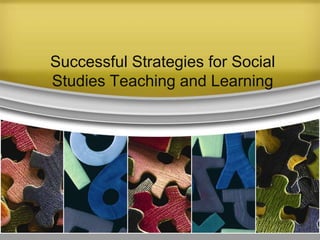
Mai edited
- 1. Successful Strategies for Social Studies Teaching and Learning
- 5. 1. Effective Learning and teaching is founded on an understanding of learner. • Knowing disconnected facts is insufficient to produce deep learning or develop expertise. Expert strategies for thinking and problem-solving are linked to the expert’s understanding of important core concepts of “big ideas”. This suggests that courses should be organized around helping students understand these big concepts and instructors should focus on helping students understand, explain, and apply these concepts rather than focusing on memorizing large amounts of content.
- 6. Learners use what they already know to construct new understandings • Learners construct interpretations of new information and problems in ways that agree with their own prior knowledge and misunderstandings. Effective teaching involves engaging what learners already know about a subject and finding ways to build on that knowledge. It also involves detecting student misconceptions and addressing them.
- 7. Learning is facilitated through the use of metacognitive strategies that identify, monitor, and regulate cognitive processes. Metacognitive strategies include: a) connecting new information to former knowledge, b) selecting thinking strategies deliberately; and c) planning, monitoring and evaluating one’s own thinking processes. Students need to reflect on what they already know and what they need to know for situations. They must consider both factual knowledge and strategic knowledge (how and when to use what procedures to solve the problem). Instructors should provide explicit instruction in the use of such skills and opportunities for students to observe others solving problems (including experts) and by making their thinking available to observers.
- 8. Learners’ motivation to learn and sense of self affect what is learned, how much is learned, and how much effort will be put into the learning process. • Internal and external factors motivate people to learn. Learners’ level of motivation strongly affects their willingness to persist in learning difficult material or challenging assignments.
- 9. The practices and activities in which people engage while learning shape what is learned. • The way people learn a particular area of knowledge and skills and the context in which they learn it becomes a fundamental part of what is learned. This means that when students learn a subject in a limited or narrow context, they often miss seeing the applicability of using that information to solve new problems encountered in other situations.
- 10. Learning is enhanced through socially supported interactions. • Learning is enhanced when students can interact and collaborate with others on learning tasks. Learning environments that encourage collaboration, similar to those of real-world scientific, mathematical, clinical, or business work, gives students the chance to test their ideas and learn by observing others.
- 12. – Teachers tell the students the concept or skill to be learned and then lead them through instructional activities designed to result on student learning. – based on behavioristic learning principles (e.g. getting students' attention, reinforcing correct responses, providing corrective feedback, practicing correct responses) – higher use of academic learning time (time on task) – teacher structured lessons, following a clear, sequential approach, with teacher in control of the content, activities, and lesson pacing. – usually used to teach new skills or concepts (often use deductive methods) – academically focused, with teacher stating the goals for the lesson – teacher monitors student understanding and provides feedback
- 13. Indirect Instruction Strategies
- 14. • Indirect instruction seeks a high level of student involvement in observing, investigating, drawing inferences from data, or forming hypotheses. • It takes advantage of students' interest and curiosity, often encouraging them to generate alternatives or solve problems. • In indirect instruction, the role of the teacher shifts from lecturer/director to that of facilitator, supporter, and resource person. The teacher arranges the learning environment, provides opportunity for student involvement, and, when appropriate, provides feedback to students while they conduct the inquiry. • In contrast to the direct instruction strategy, indirect instruction is mainly student-centered, although the two strategies can complement each other.
- 15. – Limited teacher direction, with emphasis on students co- creating their learning with the teacher as a facilitator of their learning. – May use social instructional approaches (learning with other students) or students working independently. – Often based on constructivist principles where students create meaning through active engagement and investigation. Constructivism promotes (a) the student point-of-view (b) teacher-student or student-student interaction (c) questioning to promote student thought (d) nurturing of student reflection rather than emphasis on a single correct answer. – tend to use more inductive methods (leading students to discover concepts)
- 17. • Indirect instruction is an approach to teaching and learning in which concepts, patterns, and abstractions are taught in the context of strategies that emphasize concept learning, inquiry, and problem solving.
- 18. Reference • http://www.eric.ed.gov/ERICWebPortal/search/de tailmini.jsp?_nfpb=true&_&ERICExtSearch_Sear chValue_0=ED401519&ERICExtSearch_SearchT ype_0=no&accno=ED401519 • http://olc.spsd.sk.ca/de/pd/instr/indirect.html • http://www.d.umn.edu/~hrallis/courses/3204fa04/ planning/instr_strats.htm • http://wps.prenhall.com/chet_borich_effective_6/ 48/12538/3209831.cw/-/3209833/index.html
- 19. BUILDING BRIDGES Ma. Antonette Pamittan
